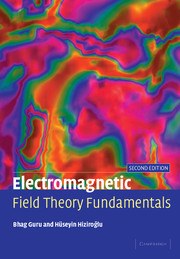Book contents
- Frontmatter
- Contents
- Preface
- Acknowledgments
- 1 Electromagnetic field theory
- 2 Vector analysis
- 3 Electrostatics
- 4 Steady electric currents
- 5 Magnetostatics
- 6 Applications of static fields
- 7 Time-varying electromagnetic fields
- 8 Plane wave propagation
- 9 Transmission lines
- 10 Waveguides and cavity resonators
- 11 Antennas
- 12 Computer-aided analysis of electromagnetic fields
- Appendix A Smith chart and its applications
- Appendix B Computer programs for various problems
- Appendix C Useful mathematical tables
- Index
Preface
Published online by Cambridge University Press: 05 June 2012
- Frontmatter
- Contents
- Preface
- Acknowledgments
- 1 Electromagnetic field theory
- 2 Vector analysis
- 3 Electrostatics
- 4 Steady electric currents
- 5 Magnetostatics
- 6 Applications of static fields
- 7 Time-varying electromagnetic fields
- 8 Plane wave propagation
- 9 Transmission lines
- 10 Waveguides and cavity resonators
- 11 Antennas
- 12 Computer-aided analysis of electromagnetic fields
- Appendix A Smith chart and its applications
- Appendix B Computer programs for various problems
- Appendix C Useful mathematical tables
- Index
Summary
Electromagnetic FIELD THEORY has been and will continue to be one of the most important fundamental courses of the electrical engineering curriculum. It is one of the best-established general theories that provides explanations and solutions to intricate electrical engineering problems when other theories are no longer applicable.
This book is intended as a basic text for a two-semester sequence for undergraduate students desiring a fundamental comprehension of electromagnetic fields. The text can also be used for a one-semester course as long as the topics omitted neither result in any loss of continuity of the subject matter nor hamper the student's preparation for the courses that follows. This text may also serve as a reference for students preparing for an advanced course in electromagnetic fields.
The first edition of this book appeared in 1998 and was well accepted by both the students and the faculty. Among the numerous comments we received from the students, the one that transcends the others is that the book is written in simple, everyday language so that anyone can easily understand even the most sophisticated concepts of electromagnetic fields. We attribute such a favorable comment to the fact that the book was written from first-hand experience of class-room teaching. The development of this second edition also follows the same time-tested approach.
- Type
- Chapter
- Information
- Electromagnetic Field Theory Fundamentals , pp. xi - xivPublisher: Cambridge University PressPrint publication year: 2004

